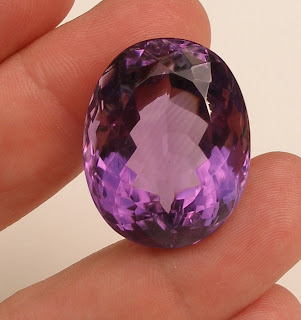Readers, I am very sorry that I did not get a photo of the absolutely gorgeous clear, faceted green amber that I was shown last month in Teófilo Otoni.
For one thing, I almost never buy something the first time I see it. I have to wait and investigate. Today, I finally found an article about this beautiful stone.
OK, of course, it is not from Brazil -- I am pretty sure of that.
This is what happened. I was sitting in the office of a dealer I like and trust, and he's telling me stories about this stone and that, when he mentions this guy who left a couple of bags of stones for him to sell if he finds any buyers.
The first bag was of those now notorious "andesine" labradorites from Mexico (or China, if you drink the cool aid). They were a very light golden color, not red. But they were easily recognizable. I'm like... uh, no thanks.
Then, he gets out a bag of these gorgeous dreamy green ambers. They reminded me of the color and clarity of the best sweet white wine I have ever had in my life, a golden nectar of the gods from Hungary that I drank back in 1979 -- you know, the kind of wine you never forget.
These faceted green amber gems were the type of stone that makes your eyes light up involuntarily as soon as you see them, and you lean forward, and everything about you tells the seller that you want them, and you want them bad!
Then, he tells me the per carat price.
Fortunately for me, or unfortunately, as the case may be, I was so damned cash poor that they were completely out of my league, especially as I didn't even really know what they were.
The dealer told me that a Japanese buyer had taken some away to be tested to see if they were really amber or not, and that he had come back and said that, yes, it was real amber, but he also didn't much like the price.
It was already late in the day, so I couldn't take a photo. However, today, while I was trying to find articles about the process for stabilizing amber, I ran across one on the treatment for green amber, so below, I am posting three photos taken by the author, Dr. Lore Kiefert, of the AGTA. I don't have permission, so eventually I may have to take these photos down. None of these stones was faceted, and only the really nice ones come anywhere near the stones I saw in Teófilo Otoni, but I think they will give you a pretty good idea.



All three photos were taken by Dr. Lore Keifert, who owns the copyright to their reproduction.
Below is the link to Dr. Lore Keifert's original article on the treatment process; UPDATE, October 14, 2009 -- the link is broken, and I have read on a forum that going to the AGTA site could involve receiving a Trojan virus, so please be careful there:
http://www.agta-gtc.org/amber-green.htm












